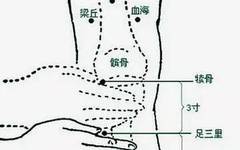The best platform for health maintenance, professional techniques, and learning exchange! Follow “Acupuncture Points and Meridians” to understand yourself comprehensively.
Among these twelve acupuncture points, eight are located from the knee to the foot, and four are from the elbow to the hand. The San Li (St36) point
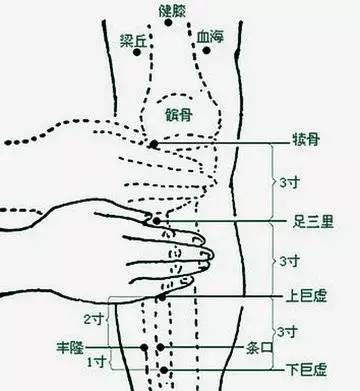
Its main function is to treat “cold in the stomach” and can also be used to alleviate abdominal distension. Symptoms of cold in the stomach include intestinal sounds, like a “soft…” sound resembling water movement, and diarrhea. The “Four Total Acupuncture Points Song” states, “San Li is where abdominal diseases can be treated,” meaning any gastrointestinal issues can be addressed at the San Li (St36) point. In surgical terms, it can also treat leg swelling, knee pain, and shin soreness.
The acupuncture meridian point map indicates that in internal medicine, typhoid-like colds, as well as emaciation and fatigue, are often due to chronic diseases, leading to poor gastrointestinal function and emaciation, along with “Qi Gu” (Qi stagnation), which refers to abdominal distension due to poor digestion and inadequate moisture excretion.
Additionally, it is an excellent acupuncture point for the elderly. For individuals over thirty, acupuncture at the San Li (St36) point can improve eyesight; as most people begin to develop presbyopia after forty, regular stimulation of this point can yield significant benefits, but precise location is essential.
Needling to a depth of eight fen or moxibustion to three cun is recommended. Based on my own experience, frequent acupuncture at this point not only promotes longevity but also enhances walking ability for long distances or climbing.
There is a saying, “If you want peace, frequently use San Li (St36) for moxibustion,” meaning that frequent moxibustion should create scarring and keep the area moist, even allowing for pus formation, which can treat age-related issues such as high blood pressure. Regular moxibustion can significantly improve blood circulation, preventing excessive blood pressure increases.
Nei Ting (Sp8)
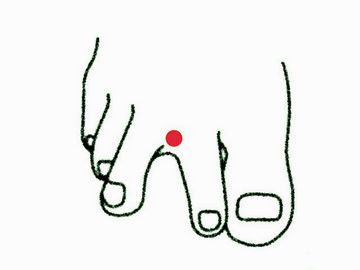
This is the Ying (ying) point of the Stomach Meridian of the Foot Yangming, located five fen between the second and third toes. It is primarily used to treat cold extremities and can also address the “heat symptoms of the Stomach Meridian” in individuals who prefer quiet and dislike noise, as well as conditions like wind rash, sore throat, frequent yawning, and toothache.
Frequent yawning indicates a lack of oxygen. In TCM, teeth belong to Yangming; the lower teeth belong to the Hand Yangming Large Intestine Meridian, while the upper teeth belong to the Foot Yangming Stomach Meridian, so toothache here refers to upper tooth pain. Additionally, if one is extremely weak and unable to eat, needling this point can provide immediate relief.
Qu Chi (LI11)
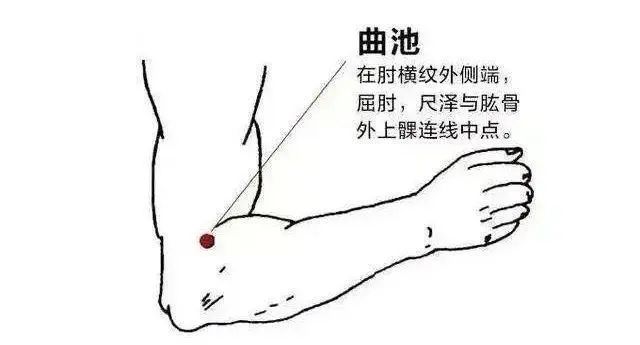
This is the He point of the Hand Yangming Large Intestine Meridian. To locate it, slightly bend the arm with the palm facing the heart; the highest line of the meridian on the arm is called the Hand Yangming Large Intestine Meridian, and the point at the elbow bend is called Qu Chi (LI11).
The “Ma Dan Yang Twelve Acupuncture Points Song” states, “Qu Chi is found by cupping the hands together;” “Seek along the edge of the finger bones.” Its function is to “effectively treat elbow pain” and can also be used for “wind stroke,” which refers to hemiplegia symptoms, as well as inability to bend or retract the hand, indicating weakness and poor nerve function, making it impossible to draw a bow.
Thus, the “Ma Dan Yang Twelve Acupuncture Points Song” states, “Wind stroke causes the hand to not retract, making it impossible to draw a bow.” When issues arise in the Large Intestine Meridian, it can also lead to “muscles relaxing, making it impossible to comb hair.” Needling Qu Chi (LI11) can also treat “throat obstruction leading to death,” indicating poor blood circulation in the throat, making it feel like one cannot breathe, and can also treat fever, systemic urticaria, and rashes, indicating that Qu Chi (LI11) also improves immune function.
He Gu (LI4)
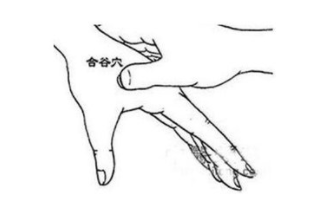
This is the Yuan point of the Hand Yangming Large Intestine Meridian, a significant point on the body located in the web between the thumb and index finger, one cun above the bifurcation of the web. It can treat “headaches and facial swelling.” The “Four Total Acupuncture Points Song” states, “He Gu treats facial and oral issues;” it can also treat “malaria with alternating fever and chills,” which refers to the symptoms of malaria with fever followed by chills.
It can also treat dental issues and nosebleeds, as well as “locked jaw,” where the teeth are tightly clenched, making it impossible to speak. Needling this point to a depth of five fen can provide immediate relief, but caution is advised as He Gu (LI4) and another point called San Yin Jiao (SP6) should be used carefully in pregnant women, as it may lead to miscarriage.
Wei Zhong (BL40)
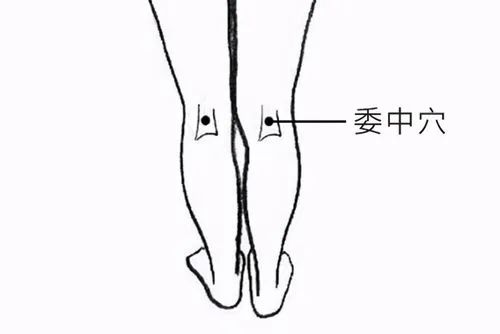
This is the He point of the Foot Taiyang Bladder Meridian, located at the back of the knee, at the bend where the thigh meets the calf, also known as the center of the horizontal crease of the knee.
It can be used to treat lower back pain that prevents standing straight, leading to a heavy feeling in the spine, and the muscles cannot relax. “Lower back pain prevents lifting, heavy pulling on the spine, and sore muscles cannot stretch” is also mentioned in the “Four Total Acupuncture Points Song” with the usage of “Wei Zhong (BL40).”
It can also treat “wind bi” (wind obstruction), which refers to blood flow obstruction. In ancient times, bi syndrome was classified into three categories: wind, cold, and damp. Wind bi is mobile, also called “moving bi;” cold bi is very painful, hence called “painful bi;” damp bi is heavy and immobile, hence called “heavy bi.” Wind bi is caused by wind leading to blood vessel obstruction, hence called “wind bi” or “moving bi.” Why is it called “unpredictable?” Because the pain does not stay in one place but moves around.
It can also treat “difficulty bending and extending the knee,” meaning inability to flex or extend the knee. “Needling provides immediate relief,” but caution is advised as this point should not be used for moxibustion due to the large blood vessel underneath.
Cheng Shan (BL57)
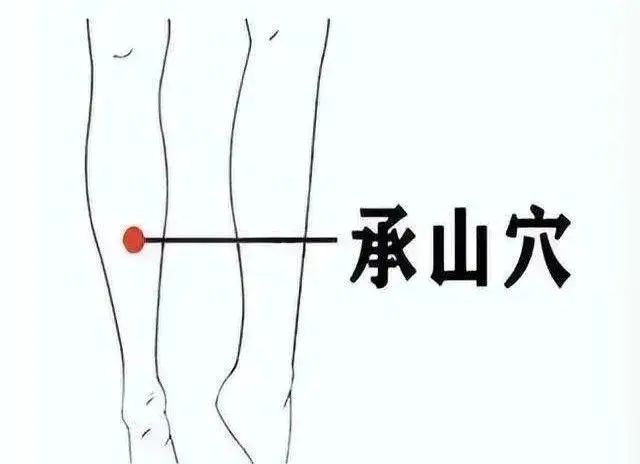
This is also a point on the Foot Taiyang Bladder Meridian, referred to in modern medicine as the gastrocnemius muscle. In ancient times, it was called “Yuan,” meaning calf. This area resembles the belly of a fish, hence in the “Ma Dan Yang Twelve Acupuncture Points Song,” it is called “fish belly.” It is located between the gastrocnemius muscle and is effective for treating lower back pain and can also relieve constipation, treat hemorrhoids, and alleviate “athlete’s foot and knee swelling.” If the limbs experience “pain and soreness, cholera, and cramps, needling will provide relief.”
Tai Chong (LR3)
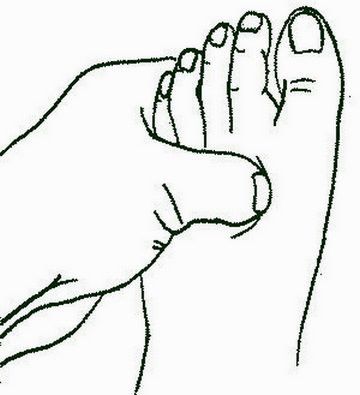
This is the Shu point of the Foot Jueyin Liver Meridian, also the Yuan point of the Liver Meridian, located about two cun above the space between the big toe and the second toe. The primary function of this point is to assess and understand a person’s life and death; if the pulse is found to be absent here, the person’s life is in danger.
This point can also treat “shock seizures,” which refers to convulsions, foaming at the mouth, and eyes rolling back due to fright. In TCM, sudden illnesses are referred to as wind, hence termed “shock seizures.”
Tai Chong (LR3) can also treat throat issues and heart diseases. Since the Liver Meridian governs tendons, it can also address difficulties in walking. Additionally, it can treat “prolapse” among the seven types of hernias, which refers to protrusion from one side of the scrotum or labia. Tai Chong (LR3) is a very useful point. Besides using Tai Chong (LR3), there is another point called “Triangle Moxibustion,” located below the navel; if the left side is protruding, moxibustion should be applied to the right side, and vice versa. Combined with Tai Chong (LR3), the effect is excellent. Furthermore, Tai Chong (LR3) can treat cloudy vision, making it seem as if something is covering the eyes. It can also alleviate lower back pain, and “needling has miraculous effects.”
Kun Lun (BL60)
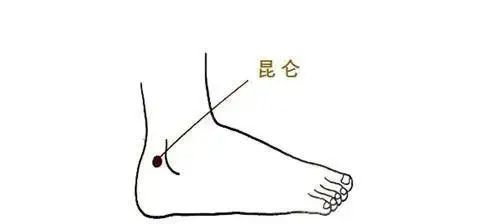
This point belongs to the Foot Taiyang Bladder Meridian. Among the “Ma Dan Yang Twelve Acupuncture Points,” there are three points on the Bladder Meridian: Wei Zhong (BL40), Cheng Shan (BL57), and Kun Lun (BL60), located between the back of the outer ankle and the Achilles tendon. It can be used to treat foot cramps, as well as pain in the lower back and buttocks.It is also used to treat sudden asthma attacks, which refers to sudden shortness of breath and fullness in the heart area; it can also treat difficulty walking, causing groaning with movement. If one seeks comfort, consider using Kun Lun (BL60) for treatment.Combining Kun Lun (BL60) with Wei Zhong (BL40) is very effective for treating lower back pain.
Huan Tiao (GB30)
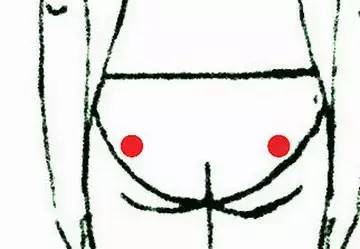
This point is located on the Gallbladder Meridian, at the upper side of the hip joint, a significant point. The muscle above Huan Tiao (GB30) is very thick, requiring a long needle to reach the point, sometimes even a six-inch needle. The method of locating this point is unique: lie on the side, bend the lower leg, and keep the upper leg straight.
It can treat “waist pain that cannot be turned,” meaning the waist feels as if it is broken, making it impossible to bend or turn. It is effective for wind, cold, and damp bi; it can also treat pain radiating from the hip to the calf, and turning can be heavy and painful, making it unbearable. Needling Huan Tiao (GB30) can provide quick relief.
Yang Ling Quan (GB34)
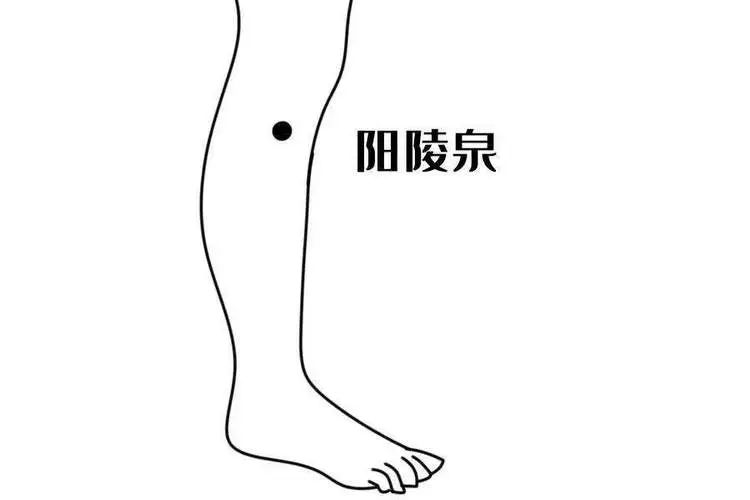
This is the He point of the Foot Shaoyang Gallbladder Meridian, located just below the knee, where the tibia is located. The bone behind the tibia is called the fibula in modern medicine, while in TCM, it is referred to as the “auxiliary bone.” The protrusion of the auxiliary bone is a small bone, and just below it is a hole called Yang Ling Quan (GB34).
The “Nanjing” mentions the so-called “Eight Meeting Points,” one of which is called “Muscle Meeting,” which is Yang Ling Quan (GB34). This point is primarily used to treat muscle pain.
Tong Li (HT5)
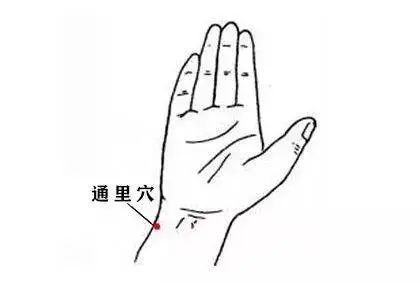
This is the Luo point of the Heart Meridian, located one cun above the wrist. This point can treat “the desire to speak but unable to” and psychological issues such as anxiety and restlessness.
If the patient has a strong constitution, they may experience heaviness in the limbs and redness in the head, cheeks, and face; if the patient is weak, they may be unable to eat, suddenly become mute, or have a pale and dull complexion. This point can be used for treatment.
Lie Que (LU7)
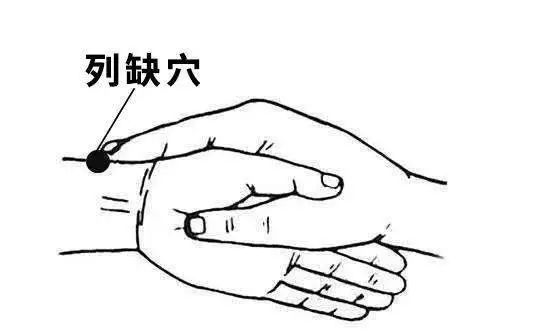
This is the Luo point of the Lung Meridian, located at the intersection of the thumb and index finger, where the index finger points to the upper side of the wrist at the radial bone edge. It can be used to treat migraines, as well as numbness throughout the body, phlegm rising, and locked jaw. If the tonification and sedation are appropriate, the patient can recover quickly. The “Four Total Acupuncture Points Song” states, “Seek Lie Que for head and neck issues,” meaning that any problems related to the head and neck can be treated at this point.
Give a thumbs up and let’s work together for health!
Easy health maintenance, you can do it too—teaching you simple and effective TCM health secrets to enjoy health and happiness.

